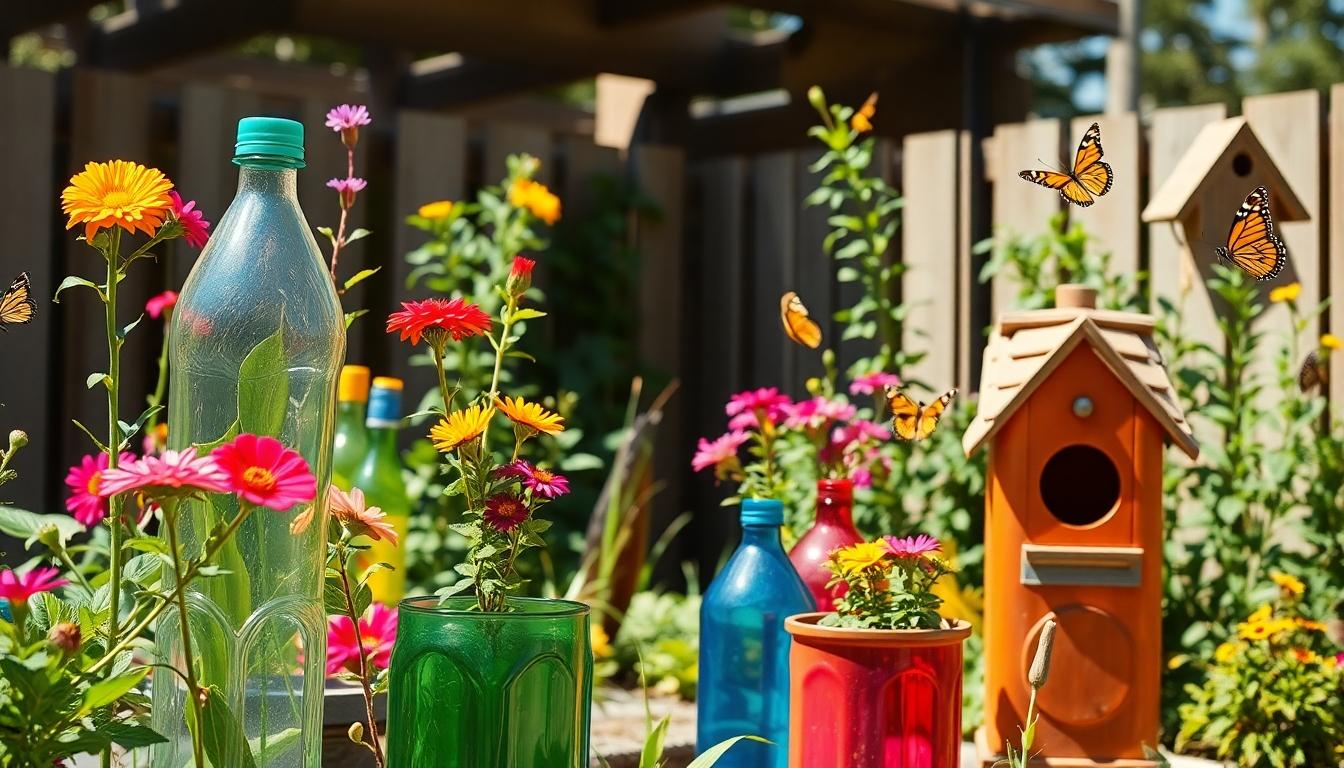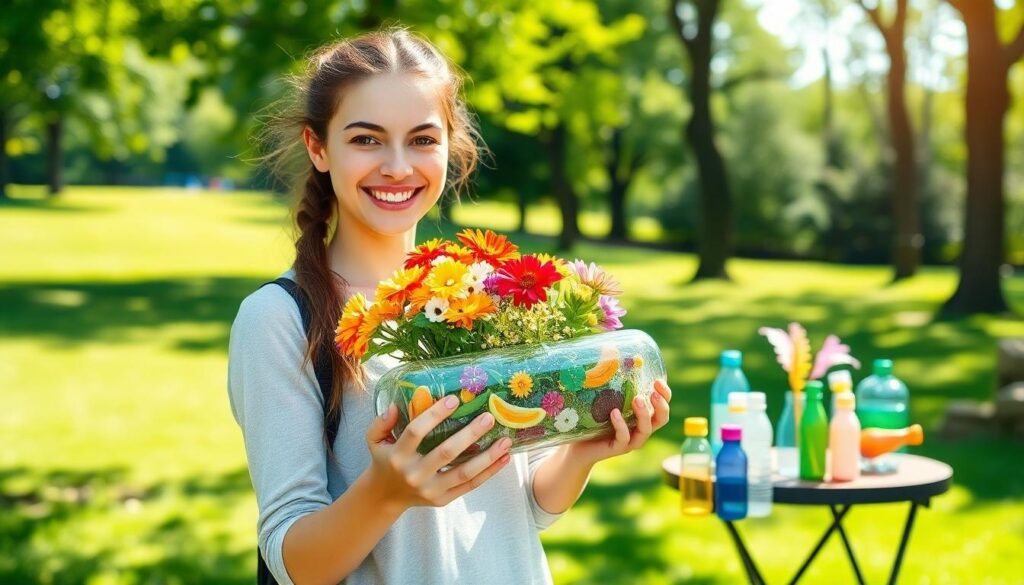Ever wondered what happens to those plastic bottles you toss in the trash? They don’t just disappear—they contribute to a growing environmental crisis. Every year, millions of plastic bottles end up in landfills and oceans where they’ll remain for hundreds of years, slowly breaking down into microplastics that harm wildlife and eventually find their way into our food chain.
We’re here to show you why those empty bottles deserve a second chance. From creative DIY projects to proper recycling techniques, there are countless ways to give plastic bottles new life. Not only will you reduce your environmental footprint, but you’ll also discover innovative answers that can save money and resources. Let’s explore how small changes in how we handle plastic waste can make a important impact on our planet’s future.
Why Plastic Bottles Shouldn’t End Up in Landfills
Plastic bottles take up to 450 years to decompose in landfills, releasing harmful chemicals throughout their breakdown process. Environmental agencies report that Americans alone discard about 35 billion plastic bottles annually, with only 25% being recycled properly. These non-biodegradable items consume valuable landfill space that’s rapidly diminishing in many regions.
Methane emissions from landfills contribute significantly to greenhouse gas production when plastic waste decomposes without oxygen. Research shows that plastic in landfills leaches toxic chemicals like BPA and phthalates into soil and groundwater systems, contaminating local water supplies. Wildlife often mistakes plastic waste for food, leading to thousands of animal deaths yearly from ingestion or entanglement.
Manufacturing new plastic bottles requires approximately 17 million barrels of oil annually—enough to fuel 1 million cars for a year. Recycling just one ton of plastic saves the equivalent of 1,000–2,000 gallons of gasoline in energy costs. Communities near landfills face increased health risks, including respiratory problems and decreased property values, directly linked to plastic waste accumulation.
Microplastics formed during plastic bottle degradation have been detected in drinking water systems worldwide, with an average person potentially consuming 5 grams of plastic weekly—equivalent to a credit card. The economic burden of managing plastic waste costs local governments millions in taxpayer dollars that could fund education, infrastructure, or community programs instead.
10 Innovative Ways to Repurpose Plastic Bottles at Home

Don’t toss those empty plastic bottles just yet! With a little creativity, you can transform these everyday items into useful household objects. Here are ten ingenious ways to give plastic bottles a second life.
DIY Planters and Vertical Gardens
Plastic bottles make excellent planters for both indoor and outdoor gardening projects. Cut bottles horizontally and add drainage holes at the bottom before filling them with soil to create sustainable growing containers. You can design self-watering systems by inverting the top portion of a bottle into the base, allowing water to slowly seep into the soil. Vertical gardens created from multiple bottles attached to walls or fences optimize space in small apartments or patios, perfect for growing herbs, lettuce, and ornamental plants. These space-saving answers bring greenery to your home while reducing plastic waste.
Homemade Bird Feeders and Butterfly Houses
Transform plastic bottles into wildlife-friendly additions for your garden. Cut openings in the sides of bottles and add wooden perches to create accessible bird feeders that can be filled with seeds. For butterfly enthusiasts, repurpose bottles as nectar stations by inverting them with small openings containing sugar answers that attract these colorful insects. Brightly painted bottle arrangements can serve as butterfly shelters, providing protection from harsh weather conditions. These wildlife habitats not only reduce waste but also support local biodiversity in your backyard network.
Storage Answers for Small Items
Organize your home efficiently with clean plastic bottles converted into practical storage containers. Cut bottles at different heights to create containers for create supplies, nails, screws, buttons, or spices. Labels can be added for easy identification of contents, making organization simpler in cluttered spaces. Attaching bottle halves to walls creates modular organizers for small items that tend to get lost. These storage answers work wonderfully in garages, create rooms, or kitchens where small items need containment.
Kids’ Create and Educational Projects
Plastic bottles offer endless possibilities for children’s activities that combine fun with learning. Empty bottles can become sensory toys filled with colored water, glitter, and small objects for visual stimulation. Creating piggy banks from decorated bottles teaches children about saving while recycling. Mini-greenhouses made from transparent bottles demonstrate plant growth processes, serving as perfect science experiments. Children can personalize their creations with paint and markers, transforming waste into imaginative play objects. These projects not only entertain kids but also instill environmental awareness from an early age.
How Plastic Bottle Recycling Actually Works

Understanding the journey of recycled plastic bottles helps us appreciate why proper disposal matters so much. Let’s explore the fascinating process that transforms your discarded bottles into valuable new products.
The Collection and Sorting Process
Plastic bottles begin their recycling journey through curbside programs or designated drop-off sites where they’re collected from homes, businesses, and recycling centers. Once gathered, these bottles make their way to material recovery facilities (MRFs) where they undergo careful separation from other materials like metals, glass, and non-recyclable waste. Advanced sorting systems play a crucial role in categorizing bottles according to their plastic type, using resin codes that identify whether they’re PET, HDPE, or other varieties. The sorting process also considers factors like color and thickness to ensure proper classification. Before moving to the next stage, bottles undergo pre-washing procedures that remove labels, adhesives, and contaminants either through manual intervention or automated systems.
The Transformation Journey
After sorting, plastic bottles receive a thorough washing treatment to eliminate any residual substances that might compromise the recycling process. Clean bottles are then fed into industrial shredders that transform them into small flakes, which are later dried and melted down into uniform pellets called “nurdles.” These pellets serve as the raw material for manufacturers who purchase them to create new products ranging from textile fibers to containers and construction materials. Mechanical recycling represents the most common approach, involving the remelting and reshaping of plastics into new forms. Chemical recycling offers an alternative method by breaking down polymer chains into their original building blocks for future applications. The recycling industry processes over 5 billion pounds of plastic packaging in the United States annually, demonstrating the important impact of proper disposal habits on reducing landfill waste, lowering pollution from new plastic production, and supporting circular economies.
Environmental Impact of Plastic Bottle Waste

The global consumption of plastic bottles has reached staggering levels with devastating environmental consequences. Over 1 million plastic bottles are used worldwide every minute, with consumption projected to increase by 20% annually.
Ocean Pollution and Marine Life Threats
Oceans bear the brunt of our plastic bottle waste crisis, with approximately 80% of plastic bottles ending up in landfills or oceans. The Great Pacific Garbage Patch now spans an alarming 1.6 million square kilometers, creating a deadly trap for marine creatures while continuously leaching microplastics into the water. Marine animals suffer horrific injuries or death through ingestion of plastic debris and entanglement in discarded bottles. The scale of this pollution is particularly concerning as these plastics break down into smaller particles but never fully disappear, creating a persistent threat to aquatic ecosystems for generations to come.
Landfill Concerns and Chemical Leaching
Americans alone discard over 60 million plastic bottles daily, contributing to a massive waste management crisis. Landfills absorb approximately 2 million tons of water bottles annually, where they remain for up to 1,000 years before decomposing completely. During this extensive breakdown period, degrading bottles release harmful toxins including phthalates and BPA into surrounding soil and groundwater systems. These chemicals pose important long-term environmental and health risks as they contaminate local water supplies. The production process for PET plastic bottles requires substantial energy input and releases greenhouse gases throughout their lifecycle, further amplifying their negative environmental impact. With recycling rates below 30% in the United States, the vast majority of plastic bottles continue to accumulate in our environment, creating a compounding problem that grows more severe each year.
Economic Benefits of Plastic Bottle Recycling

Recycling plastic bottles delivers substantial economic advantages beyond environmental benefits. The process reduces raw material demand, conserves resources, and cuts fossil fuel consumption linked to virgin plastic production while using 75% less energy per bottle compared to new manufacturing.
Job Creation in the Recycling Industry
The recycling industry creates many employment opportunities across the value chain. Over 1 million jobs in the U.S. are supported by the plastics industry, including positions in PET manufacturing and recycling operations. Growing demand for recycled PET in food packaging and textiles continues to expand these employment prospects. Even though the job creation potential, global plastic recycling rates remain disappointingly low at just 9% worldwide and only 5-6% in the United States. These statistics indicate important untapped potential for job growth if recycling rates improve. North America’s PET recovery rate has reached 41.3% as of 2023, demonstrating progress but highlighting room for expansion in the workforce as recycling initiatives grow.
Cost Savings for Municipalities
Municipalities benefit financially from plastic bottle recycling through reduced landfill expenses and lower environmental cleanup costs. These savings help local governments allocate resources more efficiently to other essential services. Recycling minimizes the production of landfill-generated methane and cuts emissions of heat-trapping gases, reducing long-term environmental remediation costs. Current economic challenges exist as recycled plastic costs £57 more per tonne than virgin plastic due to higher processing expenses and quality limitations. The gradual increase in recycled PET use in U.S. bottles, now at 16.2% in 2023, reflects growing adoption driven by policies and consumer demand. Local governments experience indirect benefits through reduced waste management burdens while contributing to circular economy principles that create sustainable economic systems.
Creative Upcycling Projects That Transform Plastic Bottles

Before tossing those empty plastic bottles in the recycling bin, consider giving them new life with these innovative upcycling projects. Transform ordinary bottles into extraordinary items that add functionality and style to your home while reducing waste.
Furniture and Home Decor Items
- DIY Planters: Turn empty plastic bottles into charming planters for herbs or small plants by simply cutting off the bottom section and filling with soil. These lightweight containers work perfectly for starting seedlings or creating a compact herb garden on your windowsill.
- Vertical Garden: Create an impressive vertical garden using soda bottles attached to clothesline or twine. This space-saving garden solution allows you to grow multiple plants in a small area while displaying your green thumb creativity.
- Luminaries: Create beautiful hanging luminaries from clean plastic bottles by decorating the exterior and placing a small light source inside. These eco-friendly light fixtures cast enchanting patterns when illuminated, perfect for outdoor gatherings or cozy indoor ambiance.
Fashion and Accessory Ideas
- Jewelry: Create unique jewelry pieces by cutting shapes from plastic bottles and adding decorative elements. The translucent quality of certain bottles creates stunning earrings, pendants, and bracelets that resemble expensive acrylic accessories at a fraction of the cost.
- Bags: Fashion eco-friendly bags or pouches by cleaning plastic bottles, cutting them into fabric-like strips, and sewing them together. These durable, waterproof containers showcase your commitment to sustainability while providing practical storage answers.
- Airplane Toys: Repurpose empty shampoo bottles into airplane toys for children by adding wings made from paper or cardboard. Kids will enjoy decorating and playing with these custom-made toys that cost nothing but inspire hours of imaginative play.
- Bird Feeders: Create simple bird feeders by filling plastic bottles with birdseed and hanging them outdoors with string. Wildlife will appreciate these functional feeders that bring nature closer to your home while giving plastic bottles a meaningful second life.
- Supply Cups: Use plastic bottles as storage containers for small items like buttons, beads, or create supplies. These transparent holders make it easy to see contents at a peek while keeping tiny objects organized and accessible.
Organizations Leading the Way in Plastic Bottle Recycling

While individuals can make important impacts through recycling and upcycling, several organizations around the industry are spearheading large-scale efforts to combat plastic bottle waste. These organizations are implementing innovative answers and creating sustainable systems that make recycling more accessible and effective.
Plastic Bank operates a groundbreaking global bottle deposit program that simultaneously reduces poverty and fights plastic pollution. Their social enterprise model allows community members to exchange collected plastic waste for money, creating economic opportunities while preventing plastic from entering oceans.
Global Plastic Action Partnership (GPAP) takes a collaborative approach, establishing national partnerships to address plastic pollution at a systemic level. Their work focuses on creating actionable roadmaps for countries to transition to circular economy models.
Industry Wildlife Fund (WWF) tackles the plastic crisis through their sustainable materials program, which aims to eliminate unnecessary single-use plastics and promote sustainable sources. Their global conservation efforts extend to protecting marine ecosystems from plastic pollution.
Global Initiatives Making a Difference
Countries worldwide are implementing effective systems to boost plastic bottle recycling rates. Germany’s bottle return system stands out as a remarkable success story, where consumers pay a deposit when purchasing bottled beverages that’s refunded upon returning the empty containers. This approach has significantly increased recycling rates and reduced litter.
Extended Producer Responsibility (EPR) Programs shift waste management responsibility to manufacturers, encouraging companies to design more recyclable products and establish better collection systems. These programs create financial incentives for producers to manage the entire lifecycle of their packaging.
The Plastics Pact in the UK unites businesses, governments, and NGOs in a collaborative effort toward creating a circular economy for plastics. Members commit to ambitious targets for making packaging reusable, recyclable, or compostable while increasing recycling rates and reducing plastic waste.
How to Get Involved in Your Community
Local action drives global change when it comes to plastic bottle recycling. We encourage you to actively participate in your community’s recycling programs by properly sorting your waste and following local guidelines for plastic bottle disposal.
Education plays a crucial role in expanding recycling efforts. Share information about proper recycling techniques with friends, family, and neighbors, highlighting how small actions can create important positive impacts on the environment.
Supporting organizations like Plastic Bank and WWF through donations or volunteer work helps amplify their important missions. These groups rely on public participation to extend their reach and effectiveness.
Reducing plastic use represents the most impactful approach to addressing plastic pollution. Choose reusable bottles, purchase products with minimal packaging, and select items packaged in more sustainable materials whenever possible.
Community events such as neighborhood cleanups provide hands-on opportunities to make an immediate difference. Participating in these initiatives not only removes plastic waste from the environment but also raises awareness about the importance of proper disposal and recycling.
Biodegradable Alternatives to Traditional Plastic Bottles

The next frontier in sustainable packaging is emerging through innovative biodegradable alternatives to traditional plastic bottles. Bioplastics such as polyhydroxyalkanoates (PHA) represent a promising solution, as they’re synthesized through bacterial fermentation of plant sugars or organic waste. Unlike conventional plastics, PHA breaks down into non-toxic components within months and degrades faster than polylactic acid (PLA) in diverse environments, including home composting systems.
New Materials on the Horizon
Polyethylene furanoate (PEF) stands at the forefront of sustainable bottle innovation, developed through a collaboration between Avantium and Coca-Cola. This 100% plant-based material degrades in approximately one year in industrial composting facilities and within a few years in natural environments, drastically reducing environmental persistence compared to traditional plastics. Bamboo-sucrose composites represent another breakthrough alternative, created by researchers at Northeastern University who combined bamboo fiber with sucrose to produce a water-resistant material that completely biodegrades in just 60 days. These advancements demonstrate important progress in creating functional packaging that minimizes long-term environmental impact while maintaining necessary performance characteristics.
Companies Pioneering Sustainable Packaging
Avantium leads the commercial development of sustainable packaging by scaling production of their revolutionary PEF material, directly targeting the replacement of conventional PET bottles used throughout the beverage industry. GO!PHA has formed a coalition specifically focused on advancing PHA-based packaging answers, though current global production capacity remains limited at 100,000 metric tons per year compared to 430 million metric tons for conventional plastics. Refork demonstrates practical applications by combining PHA with wood fiber to create compostable cutlery and straws, showcasing circular manufacturing principles in action. Even though these innovations, important challenges persist in the widespread adoption of biodegradable alternatives, including scalability constraints, higher production costs for materials like PHA, and the need for standardized composting infrastructure to properly process these materials at their end of life.
Practical Steps to Reduce Your Plastic Bottle Usage

Reducing plastic bottle consumption doesn’t have to be complicated. Replace single-use bottles with reusable alternatives and adopt simple habits like carrying a reusable water bottle, utilizing public water stations, and avoiding bottled beverages whenever possible. Choose products packaged in sustainable materials such as boxed water or aluminum cans. Support businesses that offer refill stations to minimize your plastic footprint.
Reusable Bottle Options for Every Lifestyle
Stainless steel bottles offer exceptional durability and insulation capabilities, making them perfect for both hot and cold beverages. Popular brands like Hydro Flask and YETI Rambler keep drinks at optimal temperatures for hours, ideal for outdoor adventures or long workdays. Glass bottles provide a non-toxic and scratch-resistant alternative that won’t impact the taste of your beverages, with The Perfect Water offering highly recommended options. Completely plastic-free designs from brands like Owala FreeSip use stainless steel construction with leak-proof lids, creating the perfect companion for daily commutes. Specialized containers such as the Hydro Flask Growler (64 oz) work wonderfully for home or office use, while innovative options like Cirkul allow for customizable flavor infusions without single-use plastics.
Water Filtration Answers for Your Home
Under-sink filtration systems provide a seamless way to access clean water directly from your faucet without any plastic waste. Countertop systems featuring reverse osmosis or activated carbon filters effectively eliminate contaminants while reducing the need for bottled water purchases. Filtered pitchers from brands like Brita offer an excellent solution for smaller households or apartments where permanent installations aren’t practical. Portable filtration bottles with built-in purifiers enable access to clean water even when you’re traveling or in areas with questionable water quality. Choosing NSF-certified filters ensures verified performance and reliable contaminant removal, giving you confidence in your water quality while eliminating plastic bottle waste.
Conclusion: Your Role in Solving the Plastic Bottle Crisis
The plastic bottle crisis isn’t just an environmental issue—it’s our shared responsibility. By choosing to recycle reuse and repurpose we’re taking meaningful steps toward a cleaner planet.
Every bottle saved from the landfill represents progress whether it becomes a creative DIY project or enters the recycling stream. The shift to reusable alternatives like stainless steel or glass bottles further amplifies our positive impact.
Remember that small actions multiply. When we educate others about proper disposal and creative reuse we create ripple effects throughout our communities. The solution to our plastic problem doesn’t require perfect environmentalism—just consistent thoughtful choices that prioritize our planet’s future.
Let’s transform how we think about plastic bottles from waste to resource and build a more sustainable industry together.
Frequently Asked Questions
How long does it take for plastic bottles to decompose?
Plastic bottles can take up to 450 years to decompose in landfills. During this extensive period, they release harmful chemicals into the soil and groundwater. This slow decomposition rate is one of the main reasons why proper disposal and recycling of plastic bottles is critically important for environmental health.
What percentage of plastic bottles are actually recycled?
Only about 25% of plastic bottles in the United States are properly recycled. Americans discard approximately 35 billion plastic bottles annually, with the vast majority ending up in landfills where they consume significant space and contribute to methane emissions, a potent greenhouse gas that accelerates climate change.
How many plastic bottles are used globally?
Over 1 million plastic bottles are used every minute worldwide, with consumption projected to increase by 20% annually. Approximately 80% of these bottles end up in landfills or oceans, contributing significantly to marine pollution including the Great Pacific Garbage Patch, which poses a deadly threat to marine life.
What are some creative ways to repurpose plastic bottles at home?
You can transform plastic bottles into DIY planters, bird feeders, self-watering garden systems, organizational containers, decorative lamps, and even vertical gardens. These simple upcycling projects not only reduce waste but also create functional household items while saving money and expressing creativity.
How does plastic bottle recycling work?
Plastic bottle recycling begins with collection and sorting by type and color. The bottles are then cleaned, shredded into flakes, and melted down to remove impurities. This processed plastic can be transformed into new bottles or other products like clothing, furniture, and building materials, significantly reducing the need for virgin plastic production.
What are the economic benefits of recycling plastic bottles?
Recycling plastic bottles creates jobs in collection, processing, and manufacturing sectors. It also reduces landfill expenses for municipalities and decreases the costs associated with environmental cleanup. Additionally, recycled plastic requires less energy to produce than virgin plastic, resulting in lower production costs and reduced carbon emissions.
Which reusable bottle materials are most eco-friendly?
Stainless steel bottles offer exceptional durability and are fully recyclable at end-of-life. Glass bottles contain no harmful chemicals and are infinitely recyclable without quality degradation. Certain BPA-free plastic and silicone options can also be environmentally friendly if designed for long-term use. The best choice depends on your lifestyle needs and usage patterns.
How can I reduce my plastic bottle consumption?
Replace single-use bottles with durable reusable alternatives and carry them regularly. Install a water filtration system at home to eliminate the need for bottled water. Support businesses that offer water refill stations or package-free products. Advocate for plastic reduction policies in your community and educate others about the environmental impact of plastic bottles.
What happens to plastic bottles that end up in the ocean?
Plastic bottles in oceans break down into microplastics that contaminate marine ecosystems. Marine animals often mistake plastic for food, leading to starvation, injury, and death. These plastics also absorb toxins that can enter the food chain when consumed by sea creatures, eventually affecting human health through seafood consumption.
How effective are community recycling programs?
Community recycling programs vary in effectiveness depending on local infrastructure, education efforts, and participation rates. The most successful programs combine convenient collection systems with clear guidelines, public education, and economic incentives. Community involvement, including school programs and neighborhood initiatives, significantly increases recycling rates and program effectiveness.













